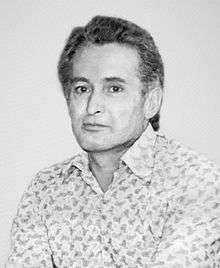Yuri Golfand
| Yuri Golfand | |
|---|---|
 | |
| Born |
January 10, 1922 Kharkov, Ukrainian Soviet Socialist Republic |
| Died |
February 17, 1994 Jerusalem, Israel |
| Fields | Theoretical High Energy Physics |
| Institutions |
Lebedev Physics Institute Technion, Haifa, Israel |
| Alma mater | Leningrad State University |
| Doctoral students | Evgeny Likhtman |
| Known for | Discovery of supersymmetry in four-dimensional quantum field theory |
| Notable awards | I.E. Tamm Prize of the Academy of Sciences of the USSR (1989) |
Yuri Abramovich Golfand (Russian: Ю́рий Абра́мович Го́льфанд; January 10, 1922, in Kharkiv – February 17, 1994, in Jerusalem) was a Russian and Israeli physicist known, in particular, for his 1971 paper (joint with his student Evgeny Likhtman) where they proposed supersymmetry between bosonic and ferminoic particles by extending the Poincaré algebra with anticommuting spinor generators. The algebra they constructed is also called a Super-Poincaré algebra. In the very same paper they presented the first four-dimensional supersymmetric gauge field theory – supersymmetric quantum electrodynamics with the mass term of the photon/photino fields, plus two chiral matter supermultiplets[1] (for a more detailed version see the Tamm Memorial Volume cited below; English translation is presented in.[2])
Yuri Golfand received Ph.D. in Mathematics (1947) from Leningrad State University; from 1951 till 1973 and in 1980 – 1990 in Lebedev Physics Institute in Moscow.
Yuri Golfand was also a Refusenik. He was fired from his work at the Lebedev Physics Institute in 1973, two years after publishing his work on supersymmetry. After 18 years of waiting, he obtained permission to leave the Soviet Union and emigrated to Israel in 1990 where he worked at the Technion in Haifa and died in 1994.
For a comprehensive biography see B. Eskin's essay in the book "Physics in a Mad World" cited below.
References
- ↑ M. Shifman & A. Yung (1971). "Extension of the Algebra of Poincare Group Generators and violation of P Invariance". JETP Lett. 13: 323.
- ↑ M. Shifman (2000). "The Many Faces of the Superworld". World Scientific: 45.
- M. Shifman. Introduction to the Yuri Golfand Memorial Volume «Many Faces of Superworld»
- Гольфанд Ю. А., Лихтман Е. П., Расширение алгебры генераторов группы Пуанкаре и нарушение Р-инвариант-ности, "Письма в ЖЭТФ", 1971, т. 13, в. 8, с. 452 (Russian). (Yu. A. Golfand and E. P. Likhtman, JETP Lett. 13, 323 (1971). Reprinted in Supersymmetry, Ed. S. Ferrara, (North-Holland/World Scientific, Amsterdam — Singapore, 1987), Vol. 1, page 7. )
- Yu. A. Golfand and E. P. Likhtman, «On the Extensions of the Algebra of the Generators of the Poincaré Group by the Bispinor Generators», in I. E. Tamm Memorial Volume Problems of Theoretical Physics, Eds. V. L. Ginzburg et al., (Nauka, Moscow 1972), page 37.
- M. Shifman, ed. (2015). Physics in a Mad World. Singapore: World Scientific. ISBN 978-981-4619-28-8.